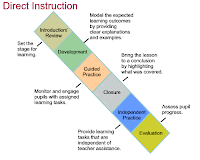I am on a journey that has multiple roads I must go down at the same time. One road of my journey is being a Gifted and Talented Teacher. Another road is leading me down my aspirations of coaching. My other road is my path to study and earn my Masters degree. These roads don't mention my personal journey I am on as well. Some days I would love my journey to be a Netflix and Chill kind of routine. But, I am grateful for the opportunity to be stretched and continuously learning in this chapter of my life. My classes bring subjects and content of things I might not have had the motivation to learn on my own.
I have been a part of the classroom for many years. I have incorporated many types of models of instruction for each classroom and matched it to my students needs. I learned what type of learners they were: visual, auditory, verbal, physical, logical, social, and solitary and which teaching instruction would give my students to best path to learn. This infographic of 7 Different Types of Learning Styles Infographic summarizes each type of learning style.
https://elearninginfographics.com/7-different-types-of-learning-styles-infographis/
Also, in the book Multiple Intelligences in the Classroom by Thomas Armstrong, he gives teachers fountain of information on the importance of teaching with different techniques to reach all students learning intelligence. He states: "MI theory makes its greatest contribution to education by suggesting that teachers need to expand their repertoire of techniques, tools and strategies, beyond the typical Word Smart and Number/Logic Smart abilities predominantly tapped in the U.S. Classroom." I have also, and still am, refining my teaching style. There are so many amazing teachers out there who actually share there art with other teachers like me and I just can't get enough. I am a firm believer that I should continually improve myself as a person and educator, stay out of my comfort zone, and keep striving for greatness.
My focus today is on one of the instructional models, Direct Instruction. This type of model is one of the most commonly used by teachers in our teaching instruction. In Instruction: A Models Approach by Thomas H. Este and Susan L. Mintz it summarizes that the goal for our students is to have clear targets, diagnostic testing, realistic goals, tasks in single steps, positive reinforcements, and good records (pg. 43). As we teach with direct instruction we are able to teach a targeted goal of what was learned, what is to be learned, and guided practice with independent practice to further student mastery skills and understanding. After that process it is impetrative to review the new content and provide corrective feedback.
Since Direct Instruction has multiple steps to guide our students to understand learning. not all students learn the same way as I have previously suggested with multiple intelligences. Also, not all students learn at the same level which is why differentiation is so important for student engagement. I usually differentiate direct instruction to fit the needs of my gifted students. In a general education classrooms there must be differentiating since student learning is on so many various levels. My gifted students meet in small groups of about 4-14 students. There is still differentiating within these groups of giftedness. The book Instruction: A Models Approach the direct instruction strategy is to:
1. Have flexible grouping which allows students to practice new knowledge and skills with peers of similar interest, skills, and achievement.
2. Produce various questioning based on the learner's readiness, experiences, and interest (pg. 55).
The questioning comes from the well known: Blooms Taxonomy. It coincides with exactly what I want to accomplish and the strategies to get my students to think in certain ways. It is adaptable in many ways so I can teach my gifted students at the higher level they need.







Hi Joann, I enjoyed reading your blog, it must be fun teaching gifted students. I really love how you incorporate engaging activities for your students and you still differentiate your instruction.
ReplyDeleteYou covered a lot of material and sited them very well. Just a suggestion, you might want to run it through spell checker. Also, I was hard for me to find where to post my comment, so you might want to make it bigger.